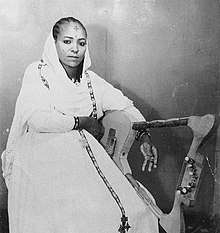Tsehaytu Beraki
Tsehaytu Beraki (1 September 1939[1][2] – 24 May 2018) was an Eritrean musician, poet and political activist, known for her singing and playing of the krar (a five-string harp).[3]
Tsehaytu Beraki | |
|---|---|
 | |
| Background information | |
| Born | September 1, 1939 Asmara, Eritrea |
| Origin | Quatit, Eritrea |
| Died | May 24, 2018 (aged 78) Rotterdam, Netherlands |
| Instruments | Vocals, kebero, krar |
Early life
Tsehaytu Beraki was born in 1939, in the small town of Quatit.[3] She had thought that she was born in Eritrea's capital city Asmara, but in fact only moved there as a baby.[4] It was not until she returned to Asmara in 1999, that the full story was told to her by her sister Rishan.[4]
Career
Beraki started playing the krar, a five-stringed harp, when she was about eight years old, eventually playing at weddings and parties.[4] Her inspirations were Tsehaytu Ghergish, Fana Etel, and especially Tsehaytu Zennar, whose songs included Annes Ay keremneye Wala Hankas Yekunye (I need a man as soon as possible, even if he's crippled).[4]
Beraki left school at sixteen, and played the krar as her full-time career.[4] She wrote all of her own music and lyrics, and people would come from as far as Addis Ababa in Ethiopia to record her.[4] From 1964 onwards, her lyrics became more political, and "people were surprised that I dared to sing them".[4]
From March 1977, she became actively involved in the Eritrean independence struggle.[4] She eventually had to leave, moving to Sudan and in 1988, Rotterdam, Netherlands.[3] She returned to Asmara in 1999.[4]
References
- "Tsehaytu Beraki 1 September 1939 - Google Search". www.google.com. Retrieved 27 May 2018.
- "Tsehaytu Beraki - Tetterettet - archief 1991-2014". www.tetterettet.nl. Retrieved 27 May 2018.
- "Tsehaytu Beraki". Music In Africa. Retrieved 5 November 2017.
- ""Love for one country is Incomparable" Eritrea's Tsehaytu Beraki - QieNit.com". www.qienit.com. Retrieved 5 November 2017.